Discussion of different forms of three-dimensional greening and their irrigation methods in gardening
The vertical green has various forms, including roof greening, wall greening, and other forms of vertical greening. Different forms of vertical green need different irrigation methods, in order to show a good landscape effect. An unsuited irrigation method, may cause water supply reduction, as well as the plants death. This article has analyzed the different forms of vertical green, and the corresponding adapted irrigation are discussed, in order to provide a reference for vertical greening research and engineering application.
With the development of the economy and the improvement of people's living standards, while people pursue safety and convenient living space, they pay more attention to the improvement of the living environment. The space is decreasing. In order to further improve the urban environment, increase urban green volume, soften the hard landscape of urban buildings, and give full play to the ecological role of greening in the city, the development of three-dimensional greening has become an important measure for urban greening. According to estimates, the energy saving rate of three-dimensional greening on the building is above 30%, and a 5000 -square -meter green wall decreases CO2 emissions by 66.32 t each year. The three -dimensional greening can alleviate the effects of urban heat islands and absorb air pollutants. It is an important measure to control the haze to control the haze.
Foreign attaches great importance to three -dimensional greening. Japan attaches great importance to three-dimensional greening. The government stipulates that all new constructive buildings cover an area of ??more than 1,000 square meters. The building roof must be covered with green plants, otherwise it will not be approved. Germany is known as the country with the best roof greening around the world. As early as 2011, the roof green rate of Germany had reached more than 82%. However, many cities in my country have not incorporated three -dimensional vertical greening into the overall greening plan of the city. There are small application examples of more developed cities such as Shanghai and Beijing [6]. The application promotion of three -dimensional greening in my country is facing many difficulties. The important point is that the technology is not available. In the existing three -dimensional greening project, there are also cases of frequent changes in plants to change plants in the existing three -dimensional greening project. The irrigation system is an important factor in restricting the overall effect of three -dimensional greening. If the application of irrigation system is not properly applied, it is likely to cause insufficient water supply and cause a large area of plants to die. The three -dimensional greening forms are diverse. Different three -dimensional greening forms require different irrigation technologies. This article analyzes different three -dimensional greening forms, and focuses on the appropriate irrigation technology in order to provide a reference for the promotion and application of three-dimensional greening.
- Roof greening
The performance of roof green plants is largely affected by water supply, especially water supply and irrigation frequency. Except for a small part of the roof greening design, no irrigation system is required. Most of the roof greening requires the support of the irrigation system. Whether the green roof needs to set up the irrigation system depends on the following points (1) the water needs of the selected plant varieties; (2) the local rainfall; : Steaming contact and contact with the adsorption of the capillary tube. The more advanced modern roof greening system is generally designed with water storage function, but the water storage capacity is subject to the physical nature of the building (load, thickness of roof greening, etc.) and economic restrictions.
In the simple roof greening design, the design load is currently inclined to reduce the design load and reduce the overall thickness. This can often reduce the cost and reduce the roof load. However, the reduction of water storage capacity brought by this design requires the introduction of irrigation systems. The greening of the roof is mainly storage through the matrix, and the installation of the drainage layer and the water preservation layer provides additional water storage capacity.
Due to the thin substrate of the roof greening and poor water storage capacity, the traditional irrigation method is easy to form surface runoff. Therefore, irrigation should be a small amount and multiple times. The uniform water -saving irrigation method is mainly included. For the form, micro -spray and drip irrigation are two commonly used roof green irrigation methods.
1.1 spray irrigation
Spray irrigation is a method of irrigation by a spray head in a uniform spraying method, and the flow is greater than 250L/h. Due to the great impact of the wind and wind, when the spray irrigation is encountered, it will take away a large amount of water droplets and increase the loss of water. The wind will also change the shape of the water tongue and the spray distance of the nozzle, and reduce the uniformity of the spray irrigation. When the wind power is at level 3 to 4, the spray irrigation should be stopped [7]. Therefore, spray irrigation technology is not suitable for irrigation of roof greening. However, if the roof is green in a closed greenhouse and the planting area is relatively large, you can also consider using spray irrigation as appropriate.
1.2 penetration irrigation
The seepage irrigation is to bury a special fairy into the surface of the ground for 20-30 cm. The pores of the low -pressure water through the pores of the seepage seepage seepage coating pipes are moisturizing the surrounding soil in the form of infiltration. Because it reduces the evaporation of the soil, it is a water -saving micro -irrigation technology.
However, the greening of the roof generally uses inorganic composite soil or improved soil planting, low -rooted plants to reduce the load of the building. Therefore, there are several problems in the greening of the roof greening: (1) the inorganic composite planting soil with strong penetration permeability. It is easy to cause deep leakage losses; (2) poor soil humidity on the surface layer, which is not conducive to the growth of shallow root plants; (3) Currently in use, the seepage pipe is often buried in the ground. Because the plant root system is water -oriented, the seepage and irrigation pipes often suffer often suffered It is blocked and difficult to check and repair. Therefore, osmotic irrigation technology is not suitable for irrigation of roof greening.
1.3 drip irrigation
Drip irrigation is an irrigation method that uses drippers (flow rate q ≦ 12L/h), drip arrows, drip irrigation pipe (belt) and other equipment to moisten some soil near the root zone of plants in the form of dripping water or small water flow (Figure 1). Its disadvantage is that the emitter is easy to scale and block, so the water source should be strictly filtered. This irrigation method is mainly suitable for scattered plants planted in roof greening, but it is seldom used in lawns and other densely planted plants.
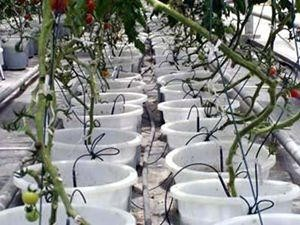
Figure 1 drip irrigation
1.4 Micro-spray
Micro-spray is also known as droplet sprinkler irrigation (Figure 2). In recent years, on the basis of summarizing sprinkler irrigation and drip irrigation, an advanced irrigation technology has recently been developed and developed at home and abroad. Micro-spray technology is more water-saving than sprinkler irrigation, sprinkler flow in 20-250L/h, it uses low-pressure water pumps and piping systems to transport water, under the action of low-pressure water, through a specially designed micro-atomization nozzle, the water is sprayed into the air, and scattered into fine mist droplets, sprinkled on the branches of crops or under the canopy of the ground A kind of irrigation method, referred to as micro-spraying. Compared with drip irrigation, the micro-nozzle outlet orifice and flow rate are greater than the drip flow rate and flow rate of drip irrigation, and the filtration requirements are smaller than drip irrigation, which greatly reduces the probability of blockage of the filler. Compared with sprinkler irrigation, micro-sprinkler irrigation has low requirements on pipeline material, good degree of atomization, low-intensity irrigation has less impact on soil and plants, and has stronger wind resistance.
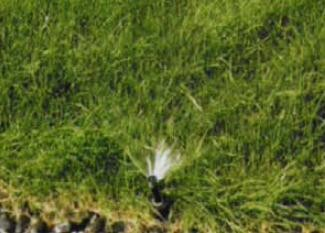
Figure 2 Micro-spray
1.5 infiltration siphon
Siphon is a technology that uses absorbent cotton to absorb water for irrigation, which is mainly used in planting containers. The lower part of the planting box (Figure 3) is a water storage layer, the upper part is a planting layer, and the middle part is separated by a soil partition board. The water in the water storage layer is sucked into the planting layer by absorbent cotton to irrigate the plants. After the water in the water storage layer is full, it is discharged from the overflow port at the side

Fig. 3 green planting box on the roof
2 wall greening
The vertical greening irrigation method is mainly automatic drip irrigation, supplemented by artificial pouring. The maintenance personnel adjust the control panel according to the specific weather conditions, the growth period of the plant, and the green wall direction, etc., and set the cycle of watering and each time.
The water inlet pipe of the irrigation system is installed vertically to the water on the side of the plant green wall. The PE pipe is set horizontally at the top of the green wall. The drip irrigation pipe is used to hit a pore out of water at a certain distance. The droplets are installed on the water pores and the droplets are installed on the green wall. According to different green forms and needs, multiple horizontal drip pipes can be set on the water inlet pipe across a certain distance. After the drip irrigation system is poured through the water, the excess water drops from top to bottom to the lower end drain tank, falls into the drainage sink, and falls into the drainage tank. Water can be discharged directly or recycled.
In the vertical greening, it is occasionally used by micro -spray irrigation. The vertical wall greening is rarely used.
2.1 box box -type vertical greening
The box -type vertical greening is a three -dimensional greening method that fix the implant box through the metal frame on the wall and perform plant planting in the planting box. Figure 4 is the green wall of the theme hall of the Shanghai World Expo. The planting box is designed in the form of a 45 -degree oblique mouth. It can ensure that the plants have sufficient growth space, but also effectively fix the plant in the planting box. Irrigation adopts the drip irrigation system, and the pressure compensation type drip head plus the arrow is used to ensure that the water pressure can be uniform and uniformly irrigated within the high difference between the 26 meters. The drip irrigation pipes are all placed on the back of the ecological green wall, and the droplets are inserted into the soil from the back of the container, which will not affect the landscape effect of the green wall. Figure 5 shows the plant wall of the China Construction Technology Center. The plant wall uses a special steel mesh planting box to plant Buddhist armor. It also uses drip irrigation methods to irrigate. The water supply tube, a drip pipe is set above the planting box, and the droplet pipe is provided with a droplet head to supplement the plant in the planting box.
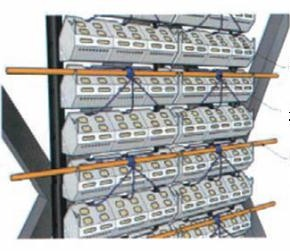

Figure 4 Green Wall of Shanghai World Expo theme Pavilion
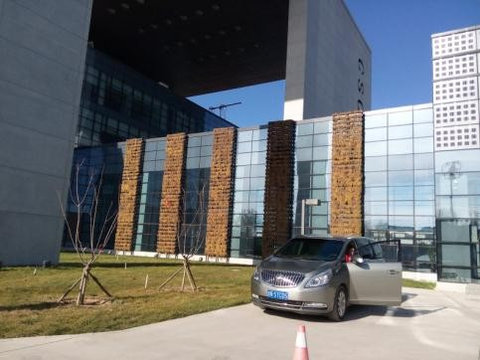
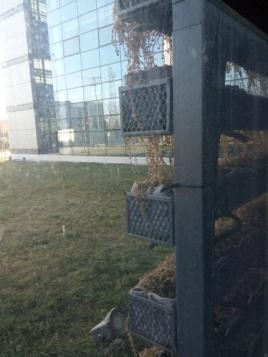
Fig. 5 Plant wall and its planting box of China Construction Technology Center
2.1 Bag vertical greening
The practice of bag vertical greening is to erect a metal lattice frame on the structural wall, then lay PVC board to form a waterproof layer, fix two layers of non-woven fabric on the waterproof layer with a nail gun, cut the surface non-woven fabric, form a pocket-like structure, and then put the plant root into the open pocket, and use the two layers of non-woven fabric as the plant root growth attachment space (Figure 6).
The irrigation system of the bag-type green wall is a network of pipes controlled by valves, the inlet pipe is set on the side of the green wall, the drip irrigation pipe is set on the top of the green wall, sandwiched between two layers of non-woven fabric, due to the permeability of the felt material, the plant can obtain the nutrient solution needed for growth, and the excess water will be collected and recycled.

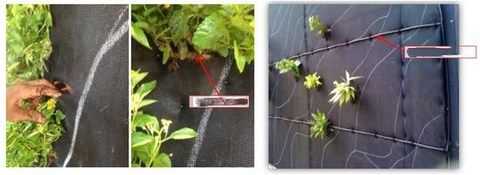
Fig. 6 Bag-type plant wall and its planting pocket and drip irrigation pipe
2.3 planting package vertical greening
Planting bag wall greening mainly refers to the use of large volume of non-woven bags wrapped in planting matrix, and in the cloth bag opening, plant planting. Similar to other forms of vertical greening, the vertical inlet pipe of the irrigation system is located on one side of the wall, and the vertical facade is distributed horizontally with drip irrigation pipes, and the irrigation water seeps into the substrate of the planting package to provide water and nutrition for plant growth (figure 7).
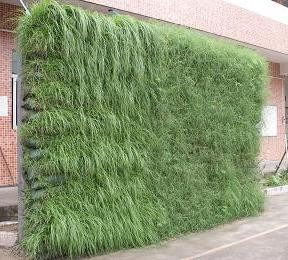
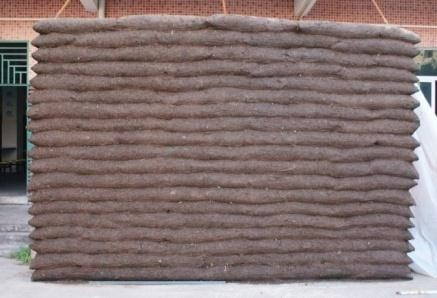
Fig. 7 planting package vertical greening
2.4 Vertical greening with walls
Wall-mounted vertical greening is one of the common vertical greening forms, with the wall surface of the building as an attachment, mostly used in residential buildings, office buildings of enterprises and institutions. The appendage type can use vines that rely on adventitious roots on the stem or suction cups to adsorb other species to climb the edge, such as climbing tigers, lingxiao, coix, ivy, etc. (Figure 8). Because the attached wall green wall plants are generally planted in the ground flower ponds, they often use artificial irrigation.

Figure 8 wall-attached vertical greening
3 Other forms of three -dimensional greening
3.1 Scaffolding three -dimensional greening
Similar to the attached three -dimensional greening, the scaffold -type three -dimensional greening also uses some climbing vines, such as wisteria flowers, Jinping vine, etc.,
climbing on the scaffolding to form a three -dimensional green landscape (Figure 9) Artificial irrigation methods are generally used.
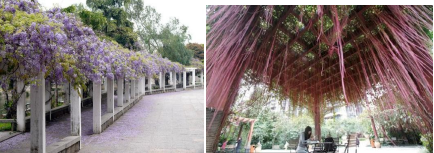
(1) Wisteria flower (2) Jinping vine
Fig. 9 Scaffold-type three-dimensional greening
3.2 Vertical three-dimensional greening
There are two forms of vertical column greening (Figure 10), one is greening the original columns, and the other is planting plants with vertical column three-dimensional flower racks. For the former, if climbing plants are planted, ground irrigation is adopted; if planting boxes or bags are used for three-dimensional greening, artificial spraying irrigation or drip irrigation system is used for irrigation. For the latter, a water pump is arranged at the lower part of the whole flower stand. Water is pumped from the vertical pipe in the center of the flower stand to the top, then flows down from the periphery to irrigate all flowerpot plants in turn, and finally flows into the water tank at the bottom to form a cycle.
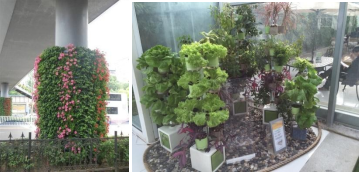
(1) (2)
Fig. 10 vertical vertical greening (1) vertical greening (2) vertical greening flower frame
3.3 suspended three-dimensional greening
Suspended virescence refers to the planting of ivy, green Apple and other downward hanging plants on the roof or balcony to form a three-dimensional greening landscape, generally using artificial irrigation or drip irrigation irrigation system (Fig. 11).
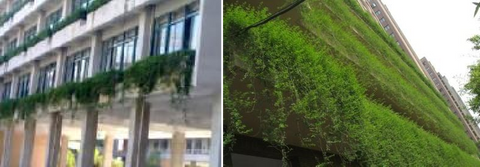
Figure 11 Overhanging three-dimensional greenery
3.4 Hydroponic three-dimensional greening
Hydroponic three-dimensional greening is a form of greening in which water is used as a medium to plant plants directly in containers containing nutrient solution. Because it does not come into contact with the soil, it is a new way of greening without harmful substances such as heavy metals, is safe and hygienic, and is free of weeds and insect pests (Fig. 12). Hydroponic three-dimensional greening, through the pipeline to the configured nutrient salts into the hydroponic container, do not need drippers, sprinklers and other irrigation.
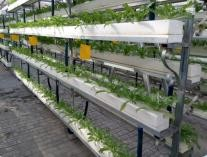


Fig. 12 three-dimensional virescence of hydroponics
3.5 creative three-dimensional greening
As shown in Figure 13, the flower pot is suspended on the roof or the wall by the rope, and the unique three-dimensional greening landscape is formed through the modeling design, which is a kind of creative three-dimensional greening form, and this creative three-dimensional greening form beautifies the life, add to the fun of life, and its irrigation for artificial irrigation or natural rainfall in the form of irrigation-free.
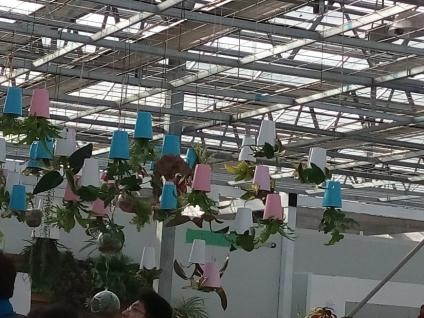
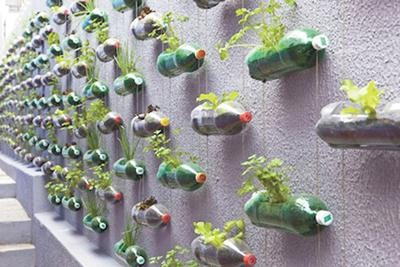
Figure 13 Creative three-dimensional greening
- Summary
Because of the strong influence of wind on sprinkler irrigation, the uniformity of sprinkler irrigation decreases, which affects the effect of irrigation and reduces the utilization ratio of water resources, it is easy to produce deep leakage, especially for the light soil with strong water permeability, more easy to produce leakage loss, so both are not suitable for roof greening irrigation.
For simple roof greening, due to the strong drought resistance of planting plants, the planting is scattered and the substrate layer is relatively thin, under normal circumstances, there is no need for regular irrigation, therefore, the drip irrigation system with high water use efficiency, low working pressure and low energy consumption is more suitable. As for the garden-type roof greening, due to its planting flowers, lawns, shrubs, trees, complex plant species, should use a variety of water-saving technology combined forms, such as the planting of lawn, ground cover class, low shrubs green area can be
Micro-sprinkler irrigation can be used to plant tall trees and shrubs in the greening area, so as to achieve the effective use of water resources. If the use of container-type planting boxes for roof greening, can be considered with water storage function of one-piece planting boxes, but it is necessary to pay attention to be timely sprinkling, to avoid absorbent cotton drying and loss of absorbent function.
For the greening of boxes, bags, and planting bags, it is mostly dripping. Because the form of micro -spray irrigation can only spray water on the plant's leaves or falls to the ground, it is difficult to wet the plant matrix, all of which are rarely used. For wall greening and scaffolding three -dimensional greening, because climbing plants are planted on the ground, they are generally used for irrigation or artificial irrigation. The suspended three -dimensional greening plant is planted on the balcony or roof, and an artificial irrigation or drip irrigation irrigation system is adopted. There are two types of cylindrical three -dimensional greening. The greening of the pillar itself is similar to the greening of the wall. Generally, drip irrigation irrigation or manual irrigation. The pipeline will use irrigation water circulation. Hydroponic three -dimensional greening is transported to the hydroponic box through the pump and pipeline, and no irrigation device is required. Creative three -dimensional greening irrigation is mostly artificial irrigation or irrigation.


Dejar un comentario: